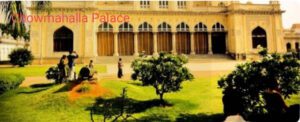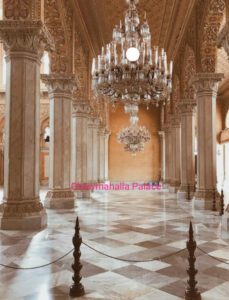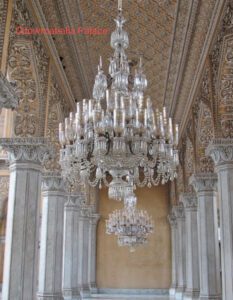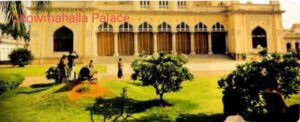Best 10 Historical Places in Hyderabad.The very thought of stepping into a bygone era, where royalty reigned supreme and opulence knew no bounds, is an alluring journey in itself. In the heart of Hyderabad lies a treasure trove of history and elegance—Chowmahalla Palace. This architectural marvel, with its name derived from ‘Chow’ meaning four and ‘Mahal’ meaning Palace, aptly translates to ‘Four Palaces.’ It serves as a mesmerizing window into the captivating history of Hyderabad and the opulent lifestyle of its rulers. As we explore the halls and courtyards of this palace, we are transported back in time, where every corner whispers tales of grandeur and legacy.

1. Chowmahalla Palace, History
• Origin of the name “Chowmahalla”
The name “Chowmahalla” finds its origins in the combination of two Persian words: “Chow,” meaning four, and “Mahalla,” meaning Palace. Collectively, it translates to “Four Palaces.” This name perfectly encapsulates the essence of the palace complex, which indeed comprises four magnificent palaces, each contributing to the grandeur and historical significance of Chowmahalla Palace. These four palaces, with their unique architectural features and rich history, make Chowmahalla Palace an exceptional and fitting name for this cultural and historical gem in the heart of Hyderabad.
• The Asaf Jahi dynasty and the palace’s construction
The construction of Chowmahalla Palace is closely intertwined with the Asaf Jahi dynasty, which ruled over the princely state of Hyderabad. The Asaf Jahi dynasty was established in the early 18th century when Mir Qamar-ud-din Siddiqi, an influential nobleman in the Mughal Empire, was appointed as the first Nizam-ul-Mulk of Hyderabad by the Mughal emperor.
The construction of Chowmahalla Palace was initiated by the fifth Nizam, Afzal-ud-Daula, who reigned from 1762 to 1803. However, it was during the reign of the sixth Nizam, Mahbub Ali Pasha, who ruled from 1869 to 1911, that the palace complex took its final form. The construction spanned over a century, starting in 1750 and concluding in 1869.
Under the patronage of these Nizams, Chowmahalla Palace evolved into a magnificent symbol of their power and refined taste. The palace served as the official residence of the Nizams and a venue for hosting dignitaries and royal guests. Its unique blend of architectural styles and meticulous design became a testament to the dynasty’s commitment to creating a seat of opulence and elegance in Hyderabad.
Today, Chowmahalla Palace stands as a testament to the enduring legacy of the Asaf Jahi dynasty and their contribution to the cultural heritage of Hyderabad. It is a living reminder of the bygone era of Nizam rule, inviting visitors to explore the rich history and architectural grandeur of this remarkable palace complex.
2. Chowmahalla Palace: The Grandeur That Remains
• The transformation from 45 acres to 12 acres
Chowmahalla Palace, once sprawling across a vast expanse of 45 acres, has undergone a transformation that reduced its size to a more modest 12 acres. This significant reduction in land area is a reflection of the changing times and circumstances that the palace has witnessed over the years.
The original expanse of 45 acres was a testament to the grandeur and opulence of the Nizams, who spared no expense in creating an estate that showcased their wealth and power. The palace complex, with its extensive gardens, courtyards, and palaces, was a true symbol of their influence in Hyderabad.
However, as the years passed and the city of Hyderabad expanded, portions of the palace’s grounds were gradually repurposed for various urban development projects and infrastructure needs. This transformation was not unique to Chowmahalla Palace but a broader phenomenon seen in many historical sites around the world as cities evolve and grow.
Despite the reduction in size, the essence and historical significance of Chowmahalla Palace have remained intact. The remaining 12 acres continue to house the magnificent palaces, courtyards, and architectural wonders that make this site a must-visit destination for those seeking to immerse themselves in the rich history and culture of Hyderabad. Visitors today can still experience the grandeur and elegance that once defined this opulent palace complex.
• A treasure trove of history and artistry
Within the remaining 12 acres of Chowmahalla Palace lies a treasure trove of history and artistry, waiting to be discovered by those who step through its majestic gates. This historical gem is a testament to the rich cultural heritage and artistic brilliance that defined the era of the Nizams.
• Historical Significance: Each corner of Chowmahalla Palace resonates with echoes of the past. It was here that the Nizams of Hyderabad, once one of the wealthiest and most influential royal families in India, held court and entertained dignitaries and guests. The palace’s history is intertwined with the rise and fall of the Asaf Jahi dynasty, and every brick and stone tells a story of power, diplomacy, and the unique blend of cultures that characterized Hyderabad.
• Architectural Splendor: As you wander through the courtyards and halls, you’ll be greeted by exquisite examples of architectural craftsmanship. The fusion of various architectural styles, including Persian, Mughal, and European influences, creates a visual feast for art enthusiasts and history buffs alike. The intricate stucco work, ornate domes, and graceful arches showcase the mastery of the craftsmen who dedicated their skills to creating this masterpiece.
• Art and Artifacts: Chowmahalla Palace houses a remarkable collection of art and artifacts that provide a window into the opulent lifestyle of the Nizams. From intricate glasswork to exquisite tapestries and furniture, each piece reflects the taste and extravagance of the era. The palace’s Council Hall, once a repository of rare manuscripts and priceless books, is a testament to the intellectual pursuits of the Nizams.
• Cultural Heritage: Beyond its historical and architectural significance, Chowmahalla Palace is a living testament to the cultural heritage of Hyderabad. It has become a venue for cultural events, exhibitions, and celebrations, keeping alive the traditions and arts of the region. Visitors have the opportunity to witness live performances and exhibitions that showcase the city’s vibrant cultural tapestry.
In essence, Chowmahalla Palace is not merely a static relic of the past; it is a dynamic hub where history, artistry, and culture converge. It invites visitors to immerse themselves in the grandeur of a bygone era, where every step reveals a new facet of the remarkable history and artistic brilliance that define this enchanting palace.

3. Chowmahalla Palace: A Stroll Through the Northern Courtyard
1. Bara Imam: Corridor of rooms with historical significance
Bara Imam, a corridor of rooms within Chowmahalla Palace, bears profound historical significance. It once housed the administrative wing, where crucial decisions of the Nizam’s court were made. This corridor resonates with echoes of power, governance, and the intricate workings of the Asaf Jahi dynasty.
2. Shishe-Alat: Guest rooms for dignitaries
The timeless Khilwat Clock
Shishe-Alat: Guest Rooms for Dignitaries
Shishe-Alat, nestled within Chowmahalla Palace, served as guest rooms for dignitaries and officials accompanying visiting guests. The name, translating to “mirror image,” hints at the reflective elegance found within. These rooms witnessed the exchange of diplomatic conversations and the hosting of esteemed guests, contributing to the palace’s rich history.
The Timeless Khilwat Clock
The Khilwat Clock, an enduring presence within Chowmahalla Palace, has measured time since its inception. A beloved relic, it has witnessed the palace’s grandeur and the passage of history. This timeless timekeeper symbolizes the enduring legacy of Chowmahalla Palace, where history itself is marked by its steady tick.
3. Council Hall: A glimpse into the past
The Council Hall at Chowmahalla Palace stands as a silent witness to the pages of history. Within these hallowed walls, the Nizam often convened with important officials, engaging in discussions of great significance. The hall was not only a place of governance but also a repository of rare manuscripts and priceless books, embodying the intellectual pursuits of a bygone era. Today, it serves as a venue for temporary exhibitions, offering visitors a precious glimpse into the rich and scholarly heritage of the Asaf Jahi dynasty.
4. Roshan Bangla: An exquisite part of the courtyard
Amidst the splendor of Chowmahalla Palace’s northern courtyard lies Roshan Bangla, a place of unmatched beauty and significance. Named after the sixth Nizam‘s mother, this architectural gem stands as a testament to the royal family’s devotion to preserving their cultural heritage.
Roshan Bangla’s intricate design and ornate detailing create an ambiance that transports visitors to an era of regal elegance. Its presence in the courtyard adds to the palace’s allure, and its rich history adds another layer of fascination to the narrative of Chowmahalla Palace.
4.Chowmahalla Palace Crown Jewel: Khilwat, the Grand Durbar Hall
• The heart of Chowmahalla Palace
its physical layout and historical significance, lies Khilwat—the grand Durbar Hall. This splendid hall, with its Mughal domes, graceful arches, and distinct Persian influence reflected in its intricate stucco work, embodies the essence of the palace.
Khilwat served as the epicenter of the Asaf Jahi dynasty’s power and prestige. It was here that the Nizams held court, conducted royal ceremonies, and welcomed dignitaries from far and wide. The grand pillared Durbar Hall boasts a pure marble platform known as Takht-e-Nishan, where the royal seat was laid, symbolizing the Nizam’s authority.
One cannot help but be captivated by the 19 recently reinstalled chandeliers crafted from exquisite Belgian crystal, which gracefully illuminate the hall. These chandeliers recreate the lost splendor of Khilwat, offering a glimpse into the opulence that once graced this regal space.
Khilwat, in the heart of Chowmahalla Palace, holds a special place in the hearts of Hyderabad’s people. It is not merely a physical space but a living legacy of the Asaf Jahi dynasty and a symbol of the city’s rich history. As visitors step into this grand hall, they are transported back in time, enveloped by the grandeur, architectural magnificence, and the echoes of a bygone era that define Chowmahalla Palace.

• Mughal domes, arches, and Persian influence
Takht-e-Nishan: The royal seat
Khilwat, the grand Durbar Hall at Chowmahalla Palace, is a captivating architectural masterpiece that seamlessly blends Mughal domes, graceful arches, and distinct Persian influence. This fusion of architectural styles and influences is a testament to the palace’s rich heritage and its role as a crossroads of cultures.
The Mughal domes add a sense of grandeur, while the graceful arches exude a sense of elegance. These elements create a visual symphony that leaves visitors in awe as they explore the hall. The intricate stucco work, a hallmark of Persian architecture, adorns the walls and ceilings, adding to the hall’s ornate charm.
Takht-e-Nishan: The Royal Seat
At the heart of Khilwat, atop a pure marble platform known as Takht-e-Nishan, the Nizam’s royal seat was laid. This platform, also referred to as the “Throne of the State,” is where the Nizam held court, received dignitaries, and conducted official ceremonies.
The Takht-e-Nishan is not just a piece of furniture; it is a symbol of authority and power. It represents the Nizam’s position as the ruler of Hyderabad and the Asaf Jahi dynasty’s seat of governance. Visitors to Khilwat can stand in awe before this platform, where history was made, and experience the grandeur and regal ambiance that once enveloped this majestic hall.
• The revival of splendor with Belgian crystal chandeliers
Khilwat, the grand Durbar Hall at Chowmahalla Palace, has witnessed the revival of its splendor through the installation of 19 magnificent Belgian crystal chandeliers. These chandeliers, crafted with meticulous precision, breathe new life into the hall, recreating the opulence that once graced this regal space.
Belgian crystal is renowned for its unparalleled clarity and brilliance, making it the perfect choice to adorn a hall of such historical and cultural significance. These chandeliers cast a shimmering and enchanting light, further enhancing the hall’s architectural beauty.
The installation of these chandeliers not only adds to the aesthetic allure of Khilwat but also serves as a symbolic restoration of the hall’s former grandeur. They are a fitting tribute to the Nizams and their commitment to creating a space of timeless elegance and prestige.
As you stand beneath the glittering Belgian crystal chandeliers in Khilwat, you are transported back in time, enveloped by the captivating ambiance that once defined Chowmahalla Palace during the era of the Asaf Jahi dynasty.
5. Chowmahalla Palace : Unveiling the Hidden Treasures
• Restoration work in progress
Restoration work at Chowmahalla Palace is an ongoing labor of love. With meticulous care, experts are preserving and reviving its historical grandeur. This dedication ensures that future generations can continue to explore the rich history and architectural brilliance that this cultural gem represents.
• Afzal Mahal, Mahtab Mahal, Tabiyat Mahal, and Aftab Mahal
Within Chowmahalla Palace lies an ensemble of palaces that adds to its mystique: Afzal Mahal, Mahtab Mahal, Tabiyat Mahal, and Aftab Mahal. These four palaces collectively form a tapestry of architectural brilliance and historical significance.
• Afzal Mahal: Named after Nizam Afzal-ud-Daula, this palace reflects the refined taste of the era with its intricate design and artistic detailing.
• Mahtab Mahal: Mahtab, meaning “moonlight,” aptly describes the ethereal beauty of this palace. Its architecture captures the essence of moonlight’s gentle glow.
• Tabiyat Mahal: Tabiyat, symbolizing “greetings,” was a place where dignitaries were welcomed. Its design and purpose exemplify the palace’s role as a diplomatic hub.
• Aftab Mahal: Aftab, meaning “sunlight,” stands as the grandest of them all. Its European façade, adorned with Corinthian columns and a parapet without a pediment, is a testament to the fusion of cultures that defined the palace.
Each of these palaces tells a unique story, offering a glimpse into the opulent lifestyle and cultural richness of the Nizams’ era. They stand as living monuments to history within the magnificent confines of Chowmahalla Palace.

6.Chowmahalla Palace : A Journey Through Time
• Immersed in the palace’s rich history
As you step through the grand gates of Chowmahalla Palace, you are instantly immersed in a tapestry of time, where every corner whispers tales of a bygone era. The palace’s rich history, dating back over two centuries, permeates the very air you breathe.
• Architectural Time Capsule: The palace’s architecture, a blend of Persian, Mughal, and European influences, serves as a living testament to the cultural exchanges that defined the era. It’s as if you’re walking through a time capsule of architectural marvels, each with its unique story to tell.
• Seat of Power: Chowmahalla was not just a palace; it was the seat of the Asaf Jahi dynasty’s power. It was here that the Nizams held court, made pivotal decisions, and entertained dignitaries. The aura of authority lingers in every pillar and courtyard.
• Cultural Heritage: Beyond the stone and mortar, Chowmahalla Palace is a repository of cultural heritage. It houses a remarkable collection of art, artifacts, and manuscripts that provide a glimpse into the opulent lifestyle, intellectual pursuits, and artistic brilliance of the Nizams.
• Evolving Through Time: The transformation from its original 45 acre expanse to the current 12 acre complex reflects the evolving needs of a growing city. Yet, the palace remains a testament to the enduring legacy of the Nizams.
As you traverse the corridors, stand beneath the grand arches, and gaze upon the shimmering chandeliers, you become a part of this rich history. Chowmahalla Palace isn’t just a destination; it’s an immersive journey through time, where the past is tangible, and the stories are waiting to be discovered.
• How the palace shaped the city of Hyderabad
Chowmahalla Palace, more than just a historical monument, played a pivotal role in shaping the identity and culture of the city of Hyderabad. Its influence extends far beyond its ornate walls, touching various aspects of the city’s development.
• Cultural Hub: Chowmahalla Palace served as a cultural epicenter where the Nizams patronized arts, music, and literature. This royal patronage fostered a vibrant cultural scene in Hyderabad, giving rise to renowned poets, musicians, and artists. The echoes of this cultural legacy continue to resonate throughout the city.
• Architectural Inspiration: The architectural marvel of the palace didn’t stop at its gates. It inspired the design and aesthetics of many buildings and structures in Hyderabad. Elements of Mughal and Persian architecture seen in the palace can be observed in other historical landmarks across the city.
• Urban Development: As the palace complex evolved, so did the city. The development and expansion of Hyderabad often mirrored the palace’s growth. The transformation of the city’s landscape, including the Laad Bazaar and Aspan Chowk Road, was influenced by the palace’s significance and prominence.
• Historical Significance: Chowmahalla Palace became a symbol of Hyderabad’s historical significance. It showcased the city’s rich heritage and its role as a center of power during the Nizam era. This historical prominence contributed to Hyderabad’s identity as a city steeped in tradition and history.
• Tourism and Economy: The palace’s allure draws tourists from across the globe, contributing to Hyderabad’s tourism industry and boosting the local economy. It has become a must-visit destination, shining a spotlight on the city’s historical and cultural wealth.
In essence, Chowmahalla Palace is more than just a structure; it’s a living embodiment of Hyderabad’s history, culture, and architectural heritage. Its influence, both tangible and intangible, has left an indelible mark on the city, shaping it into the vibrant and culturally rich metropolis it is today.
7. Preserving the Legacy
• Chowmahalla Palace as a living museum
Chowmahalla Palace stands as a living museum, where history and culture come to life. Its meticulously preserved architecture, art, and artifacts offer a vivid window into the opulent Nizam era. Visitors can stroll through time, immersing themselves in the rich tapestry of Hyderabad’s heritage within these regal walls.
• Ensuring future generations can witness its grandeur
Preserving Chowmahalla Palace isn’t just about cherishing the past; it’s about securing the legacy for generations to come. Ongoing restoration efforts, meticulous maintenance, and cultural events ensure that the palace’s grandeur remains a timeless treasure, ready to inspire and educate future visitors about Hyderabad’s illustrious history.

8. A Must-Visit Destination
• The experience of walking in royal footsteps
Walking through Chowmahalla Palace allows visitors to trace the very steps once taken by royalty. It’s an immersive journey into opulence, history, and culture, offering a rare glimpse into the lives of the Nizams of Hyderabad.
• The invitation to marvel at architectural wonders
Chowmahalla Palace extends a warm invitation to marvel at the architectural wonders that grace its halls and courtyards. From Mughal domes to intricate stucco work, each corner invites visitors to appreciate the grandeur of an era long past.
• A journey through time at Chowmahalla Palace
Stepping into Chowmahalla Palace is akin to embarking on a captivating journey through time. As you explore its regal corridors and ornate chambers, you traverse centuries, immersing yourself in the opulence, history, and cultural tapestry of Hyderabad’s storied past.
Conclusion:
Chowmahalla Palace stands as a living testament to Hyderabad’s rich history, where the realms of history, art, and elegance beautifully converge. It’s a place where visitors can not only witness the grandeur of the Asaf Jahi dynasty but also immerse themselves in the architectural wonders, cultural heritage, and the echoes of a bygone era. As this magnificent palace continues to tell its timeless tale, it extends an enduring invitation to all to experience the magic of a place where history breathes and artistry thrives.
FAQs :
1. What is Chowmahalla Palace famous for?
2. What is the best time to visit Chowmahalla Palace?
3. What is the ticket price of Chow Mahal Hyderabad?
4. Is Chowmahalla Palace worth visiting?
5. Chowmahalla Palace to Salar Jung Museum
6. Chowmahalla palace timings
7. Chowmahalla Palace Tickets


Pingback: Unlocking the Charms: What is Famous in Hyderabad? Your Ultimate Guide - solotraveler
Pingback: Solo Traveler's Dream: Affordable Drone Camera Price Unveiled - solotraveler
Pingback: Exploring the Best Sony Drone 4K Camera Price In India : Unveiling Features and Price in India - solotraveler
Pingback: The Ultimate Guide to Cultural Tourism in India: Must-See Wonders! - solotraveler
Pingback: Al-Azhar Mosque Unwrapped: From Gohar's Vision to Modern Wonders - solotraveler
Pingback: Padmanabhapuram Palace: The Best History and Art Converge - solotraveler